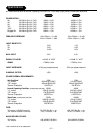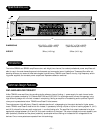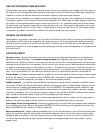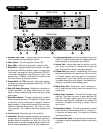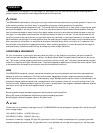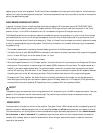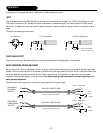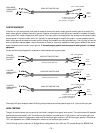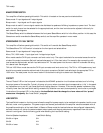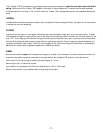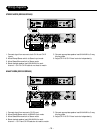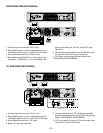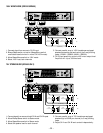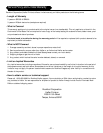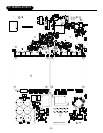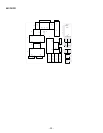
– 16 –
70V mode).
BIAMP/STEREO SWITCH
Turn amplifier off before operating this switch. This switch is located on the rear panel and selects either:
Stereo mode- 2 input signals and 2 output signals.
Biamp mode- 1 input signal and 2 output signals.
Biamp mode is useful if a mono signal needs to be distributed to speakers of differing impedance or power level. The load
switch for each channel can be selected for the appropriate load, and the level controls can be adjusted individually for
each channel. See diagrams
The Stereo/Biamp switch is defeated whenever the front panel Stereo/Mono switch is in the Mono position. In this case, the
Stereo/mono switch overrides the Stereo/Biamp switch, and the amplifier operates in mono mode.
STEREO/MONO 70V 100V SWITCH
Turn amplifier off before operating this switch. This switch will override the Stereo/Biamp switch.
This Stereo/Mono 70V 100V switch is located on the front panel and selects either:
Stereo mode- 2 input signals and 2 output signals.
Mono, 70V, 100V mode- 1 input signal and 1 bridged output signal.
Mono mode uses the CH B input connector and level control only. The output load should be connected across the red ter-
minals of the output connectors. Set both load switches equal to 1/2 the load value. For example, after connecting a 4Ω
load across the red terminals, set both load switches to 2Ω. The rated power into the mono load will be double the rating
for a stereo load. See diagram
70V and 100V Mono mode also use the CH B input connector and level control only. The 70V or 100V speaker array load
should be connected across the red terminals of the output connectors. Set both load switches to the appropriate 70V or
100V value. The rated power into the mono load will be double the rating for a stereo load. See diagram
PROTECT
The red "Protect" LED on the front panel indicates that the NOMAD protection circuit has been activated, and is limiting
the output power of the amplifier. Typically this may only occur when a transient signal corresponds to a “dip” in the speak-
ers’ impedance curve, and will not cause significant clipping distortion. However, if the nominal speaker impedance is sig-
nificantly lower than the Load Switch setting, excessive clip distortion can result, accompanied by continuous or prolonged
illumination of the protect LED. In this situation
the Load Switch should be changed to a lower value until the “protect”
events occur infrequently.
See “Load Switch” paragraph.
LOAD SWITCH
The Load Switch-located on the front panel-allows the amplifier’s power supply to be matched to the speaker load for more
efficient, cooler running operation. The power output and thermal performance of the amplifier remains consistent with all
the possible combination of the loads listed. In Stereo or Biamp mode the Load switches can be configured independently,
and each channel will deliver the same consistent output power and thermal performance, regardless of how the other
channel is configured. Use the following guide when selecting the Load Switch setting:
Nominal Speaker Impedance Load Switch Setting
5Ω-8Ω or higher 8Ω
3Ω-5Ω 4Ω
2Ω-3Ω or lower 2Ω



